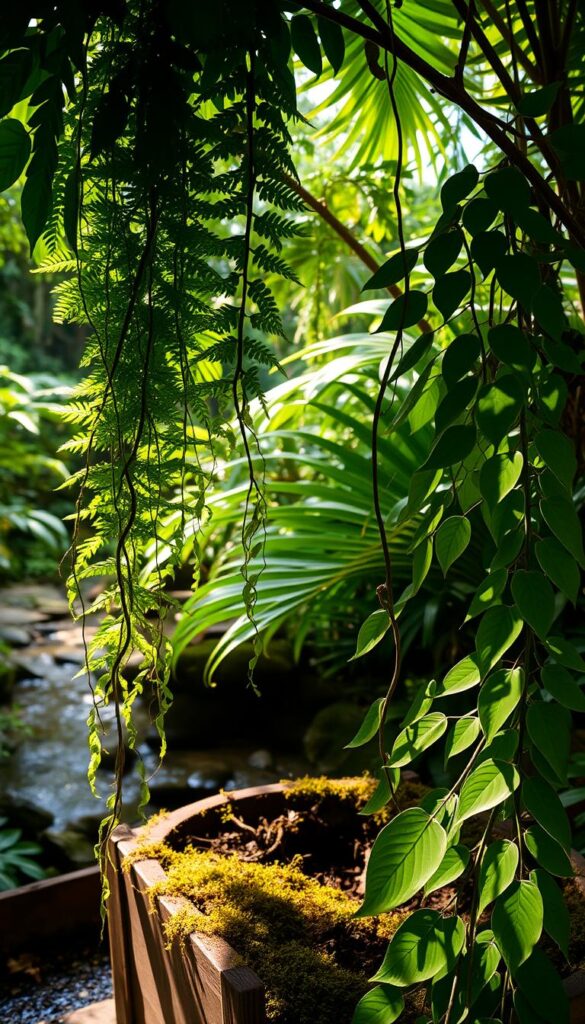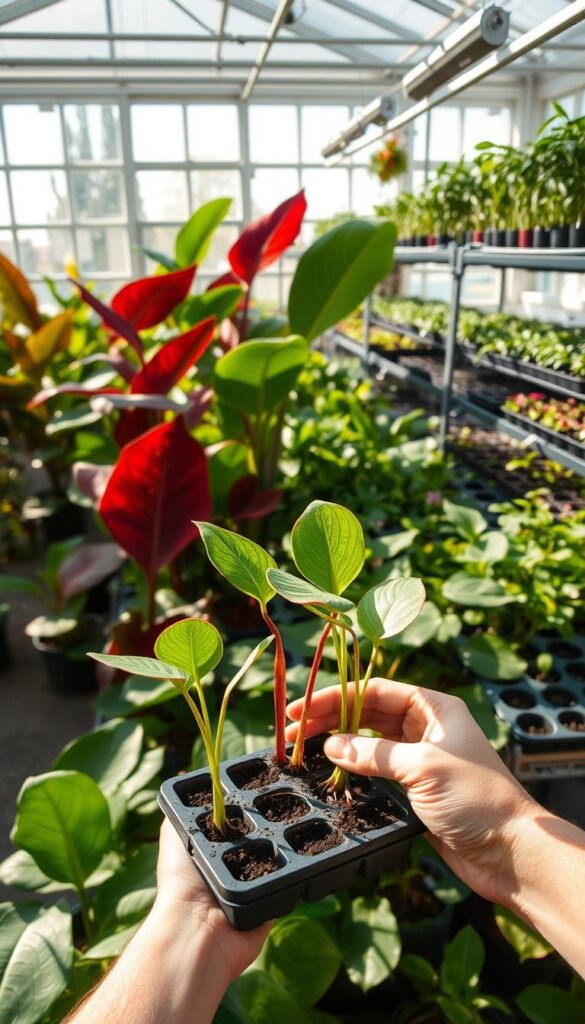Welcome to my comprehensive guide on caring for the Philodendron Goeldii! This stunning plant has captured my heart with its unique, spiraling foliage and low-maintenance nature. Whether you’re a seasoned plant enthusiast or just starting your green journey, this guide is here to help you succeed.
I chose the Philodendron Goeldii for my collection because of its striking appearance and adaptability as a houseplant. Its ease of care makes it a perfect choice for anyone looking to bring some greenery into their home. Plus, it’s non-toxic, making it a great option for families with pets or young children.
In this guide, I’ll share my personal tips and experiences to help you keep your Philodendron Goeldii thriving. From light requirements to watering schedules, we’ll cover every detail to ensure your plant stays healthy and vibrant. Let’s dive in and explore how easy it is to care for this beautiful houseplant!
Understanding Your Philodendron Goeldii
Discovering the unique charm of the Philodendron Goeldii begins with understanding its botanical background. Once classified under Philodendron, this plant is now recognized as Thaumatophyllum spruceanum, a name that reflects its distinct characteristics.
Botanical Classification and Unique Characteristics
This plant stands out with its spiraling foliage, a feature that captivates plant enthusiasts. The leaves are a marvel, showcasing intricate details that add to their visual appeal. As the plant matures, its growth pattern becomes even more intriguing, making it a fascinating addition to any indoor space.
Benefits of Adding This Plant to Your Collection
Incorporating the Philodendron Goeldii into your collection brings numerous benefits. Its striking appearance and low-maintenance nature make it a perfect choice for any home. The plant’s adaptability ensures it thrives in various environments, adding a touch of natural beauty effortlessly.
| Characteristic | Details |
|---|---|
| Botanical Name | Thaumatophyllum spruceanum |
| Leaf Structure | Spiraling, detailed foliage |
| Growth Habit | Adaptive, low-maintenance |
Understanding the plant’s name and classification is key to providing the right care. This knowledge helps in selecting appropriate techniques to ensure your Philodendron Goeldii remains healthy and vibrant. Its unique features not only enhance your indoor garden’s beauty but also contribute to a thriving ecosystem, making it a valuable addition to any collection.
Setting Up the Ideal Environment for My Philodendron
Creating the perfect home for my Philodendron Goeldii is all about replicating its natural habitat. With a few simple adjustments, you can provide the ideal conditions for your plant to thrive.
Choosing the Right Location and Light Conditions
Light is one of the most critical factors for healthy growth. I always recommend placing your Philodendron in a spot with bright, indirect light. Direct sunlight can be harsh and may burn the delicate leaves, so it’s best to filter the light using a sheer curtain or shade cloth.
East- or west-facing windows are perfect for providing the right amount of light without direct exposure. Avoid low-light areas, as this can slow down growth and make the leaves lose their vibrant color.
Optimizing Soil, Pot, and Humidity Levels
The soil mix is another essential element. I use a blend of potting soil, perlite, and orchid bark to ensure excellent drainage and aeration. This mix helps prevent waterlogging and root rot, which can be detrimental to your plant’s health.
Choosing the right pot is equally important. Opt for a container with drainage holes to allow excess water to escape. This simple step helps maintain soil health and prevents root damage.
Humidity is key for tropical plants like the Philodendron Goeldii. To maintain the ideal humidity level, I place the pot on a tray filled with water and pebbles. As the water evaporates, it creates a humid microclimate around the plant. You can also use a humidifier, especially in drier climates.
Maintaining slightly acidic to neutral soil pH (around 6.0 to 7.0) ensures your plant absorbs nutrients effectively. Regularly monitoring the soil pH and adjusting as needed will keep your Philodendron happy and thriving.

By following these steps, you’ll create a nurturing environment that allows your Philodendron Goeldii to flourish. Remember, consistency is key, so stick to these conditions and enjoy the beauty of your plant.
philodendron goeldii care guide: Essential Watering and Fertilizing Techniques
Watering and fertilizing are crucial steps in keeping your plant healthy. I’ve learned that finding the right balance is key to preventing common issues like overwatering.
Watering Frequency and Proper Techniques
To water correctly, let the top layer of soil dry slightly between sessions. Water thoroughly until you see excess flowing from the pot’s bottom. This ensures the roots stay moist but not waterlogged.
During summer, when the plant is active, I water more frequently. In cooler months, I reduce the frequency to match the plant’s slower growth. Always check the soil moisture before watering again.
Selecting the Best Fertilizer and Avoiding Overwatering
Feeding your plant with a balanced fertilizer during the growing season boosts its health. I apply it in summer, following the product’s instructions to avoid stressing the plant.
Proper drainage is vital. Use a pot with drainage holes and a well-draining soil mix to prevent water accumulation. If you notice yellowing leaves, it may be a sign of overwatering.
| Aspect | Details |
|---|---|
| Watering | Water until excess drains from the bottom |
| Fertilizing | Use balanced fertilizer during summer |
| Drainage | Ensure proper drainage to avoid waterlogging |
By following these steps, you’ll create a nurturing routine that keeps your plant thriving. Adjustments based on seasonal changes and careful observation are key to success.
Pruning, Propagation, and Ongoing Maintenance Tips
Maintaining your plant’s health and appearance involves more than just watering and fertilizing. Pruning and propagation are essential steps that not only keep your plant looking its best but also help it thrive. Let’s dive into these techniques and how they contribute to your plant’s overall well-being.
When and How I Prune for Healthier Growth
Pruning is a simple yet effective way to encourage healthy growth and maintain your plant’s appearance. I always use sharp, clean scissors to prevent spreading any potential infections. The best time to prune is during the spring or early summer when the plant is most vigorous. This period allows the plant to heal quickly and encourages new growth.
When pruning, I focus on removing any dead or damaged leaves. I make my cuts just above a node, ensuring I don’t leave any stubs behind. This method helps the plant direct its energy towards producing new, healthy foliage. Regular pruning also helps keep the top of your plant neat, which is crucial for optimal growth.
Propagation Methods for Expanding My Collection
Propagation is an exciting way to share plants with friends or expand your own collection. I prefer using stem tip cuttings for propagation. Simply cut a healthy section of the stem with sharp scissors, making sure it has at least two nodes. You can place the cutting in water or directly into well-draining soil. I’ve found that water propagation allows me to monitor the root development, which is both fascinating and effective.
Once the roots have developed, transfer the cutting to soil. Keep the soil moist but not waterlogged. With proper care, your new plant will start to grow, bringing the same beauty and vitality as the parent plant.
Seasonal Adjustments to Keep My Plant Thriving
Seasonal changes can impact your plant’s needs. During the spring and early summer, your plant is in its active growth phase, so it may require more frequent watering and fertilizing. In the fall and winter, growth slows down, so I reduce watering and skip fertilizing until spring arrives.
By adjusting your care routine seasonally, you ensure your plant remains healthy and vibrant year-round. These small adjustments make a big difference in maintaining your plant’s overall health and appearance.

| Aspect | Details |
|---|---|
| Pruning Tools | Sharp, clean scissors |
| Best Time to Prune | Spring or early summer |
| Propagation Methods | Stem tip cuttings in water or soil |
By incorporating these pruning, propagation, and maintenance tips into your routine, you’ll be able to enjoy your plant’s beauty for years to come. Remember, consistency is key to supporting long-term health and growth.
Wrapping Up My Journey to a Thriving Philodendron
As I reflect on my journey with the Philodendron Goeldii, I’m reminded of how simple it is to create a nurturing environment for this stunning plant. By focusing on proper sunlight management and maintaining the right light conditions, I’ve been able to keep my plant healthy and vibrant.
One of the most important lessons I’ve learned is the value of bright indirect light. While low light can work, it’s the balanced light condition that truly brings out the best in this plant. Regularly monitoring each leaf and node has also been crucial for maintaining its health and appearance.
I’ve found that early summer is the perfect time to give my plant a little extra attention. Seasonal adjustments, like slight changes in watering and fertilizing, make a big difference in its overall vigor. It’s all about trusting your instincts and gently experimenting with the techniques that work best for your plant.
With attentive care and the right light conditions, anyone can enjoy a flourishing Philodendron. I encourage you to embrace these proven tips and watch your plant thrive. Happy planting!
